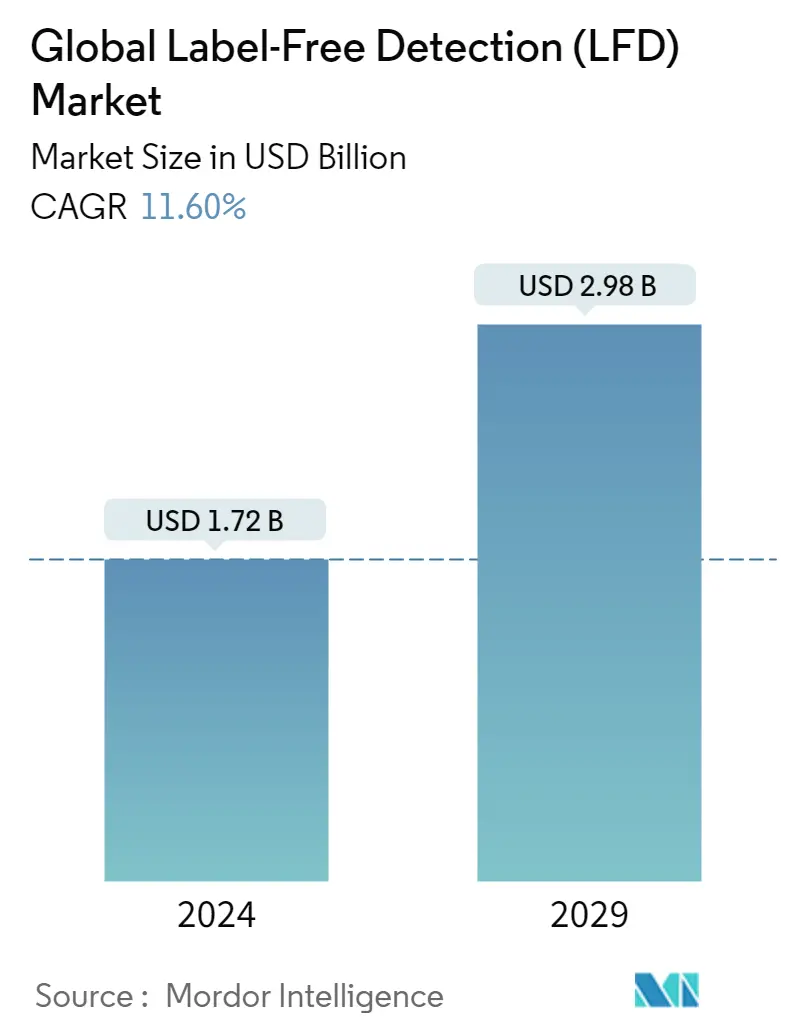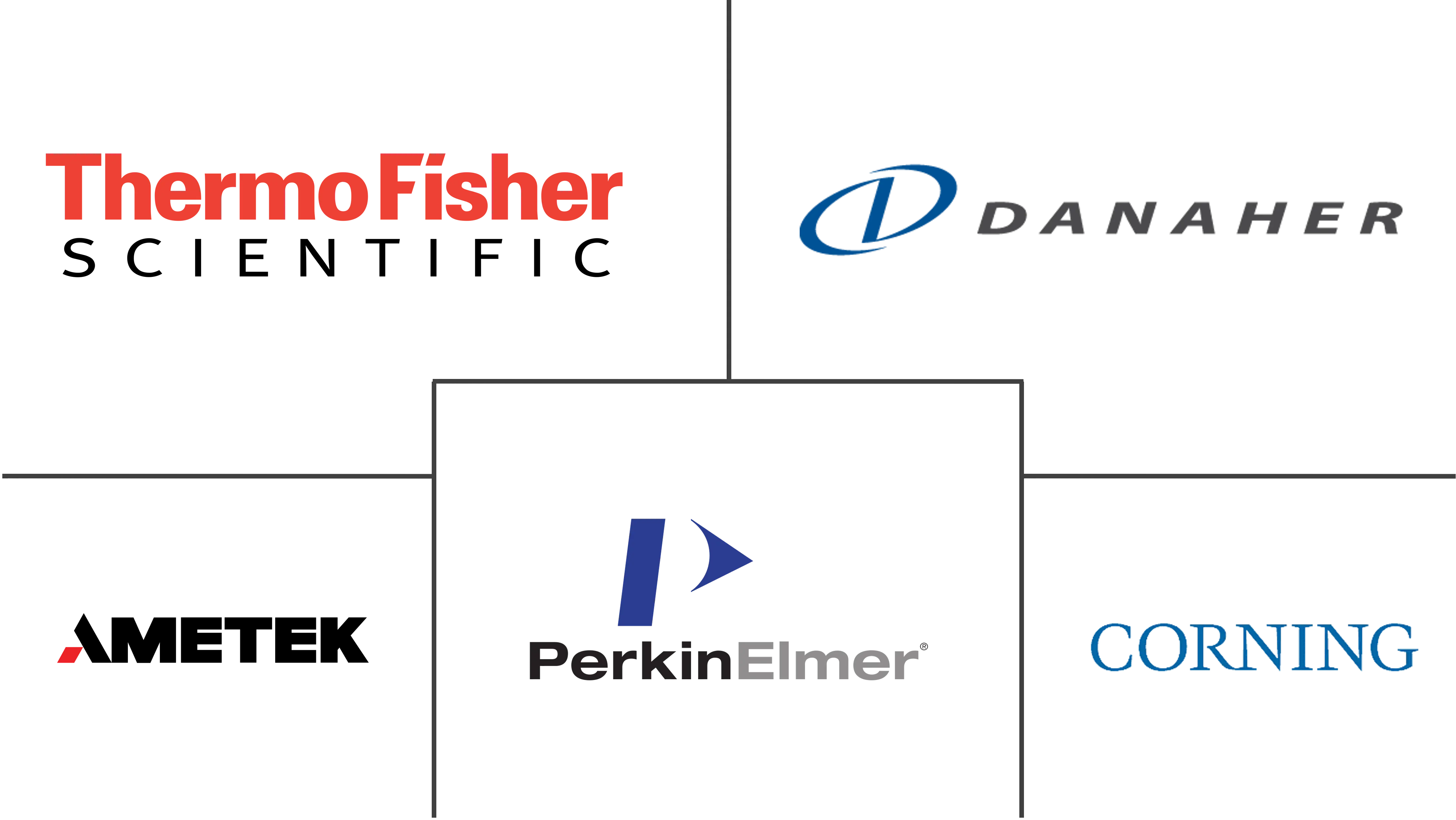Market Size of Global Label-Free Detection (LFD) Industry

| Study Period | 2019 - 2029 |
| Market Size (2024) | USD 1.72 Billion |
| Market Size (2029) | USD 2.98 Billion |
| CAGR (2024 - 2029) | 11.60 % |
| Fastest Growing Market | Asia Pacific |
| Largest Market | North America |
Major Players
*Disclaimer: Major Players sorted in no particular order |
Need a report that reflects how COVID-19 has impacted this market and its growth?
Label-Free Detection (LFD) Market Analysis
The Global Label-Free Detection Market size is estimated at USD 1.72 billion in 2024, and is expected to reach USD 2.98 billion by 2029, growing at a CAGR of 11.60% during the forecast period (2024-2029).
The COVID-19 pandemic has had a substantial impact on the label-free detection market initially. The strict lockdowns and government regulations intended to slow down the spread of COVID-19 resulted in a decrease in demand for products in the initial days of the pandemic. According to researchers based at ETH Zurich (Switzerland), Localized Surface Plasmon Resonance (LSPR) demonstrated a high degree of accuracy and sensitivity when tasked with detecting COVID-19 RNA. Surface Plasmon Resonance is one of the major technologies used in label-free detection. This is a significant indicator of market growth. In addition to this, label-free products such as SPR systems and biosensors are also being used for COVID-19 research. However, Research & Development labs are now operating below 50% of normal capacity. According to an analysis of studies based on ClinicalTrials.gov in 2020, among the 2522 clinical trial registry entries that were suspended, terminated, or withdrawn between December 1, 2019, and May 5, 2020, around 44% were closed with a reported reason that explicitly mentioned COVID-19. These factors could hinder the growth of the market.
The main advantage of LFD techniques is that more direct information can be acquired as the method uses only native proteins and ligands. Innovations in LFD techniques include modification of mass spectrometry to develop surface-enhanced laser desorption/ionization (SELDI) time of flight (TOF)- mass spectrometry (MS) which is an innovative approach that offers on-chip purification of the proteins of interest and subsequent ionization of the retained molecules to be detected. In 2021, The latest innovation in differential scanning calorimetry (DSC) from Spectris (UK) has been created specifically for regulated environments and delivers essential data to guide biopharmaceutical development. Furthermore, in June 2022, Agilent Technologies Inc. launched its new innovative and intelligent MS systems, Agilent 5977C GC/MSD, 6475 triple quadrupole LC/MS system, 7000E GC/TQ, and the 7010C GC/TQ, at the 70th ASMS Conference on Mass Spectrometry and Allied Minnesota. The advanced MS systems offer advanced sensitivity of detection, automated sample reinjection function, high throughput, efficiency, and many other advanced features which simplify lab operations. These technological advancements have increased the adoption of label-free technologies by pharmaceutical and biopharmaceutical companies as well as academic research institutes for biomolecular analysis during drug discovery. This is expected to drive market growth. Furthermore, with the introduction of new innovations in label-free detection technologies, the market is expected to experience significant growth.
Relatively new in the well-established field of High-throughput screening, label-free technologies provide opportunities for probing biomolecular interactions without spatial interference or the auto-fluorescent or quenching effects of labels. On average, it takes at least ten years for a new drug to complete the journey from initial discovery to the marketplace. As per the Congressional Budget Office data published in April 2021, the average cost of research & development for each successful drug is estimated to be around USD 2.6 billion (Pharmaceutical Research and Manufacturers of America-PhRMA). With escalating cost pressures and increasingly complex disease targets, improving productivity in early drug discovery processes has been challenging. Initially, low throughput was a major challenge associated with label-free technologies. However, the introduction of Surface plasmon resonance-based label-free systems with higher throughput has helped increase overall operational efficiency while providing the high-quality data needed to make informed decisions.
Thus, the aforementioned factors are driving the growth of the market. However, at present, there is a shortage of such professionals, forcing most companies to opt for conventional methods such as cell-based assays and fluorescence- and radioactive-labeled instruments. This poses a challenge to the label-free detection market.
